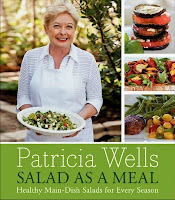I love stories. Especially when they involve food and/or travel. In my opinion, a good cookbook MUST have a good story behind it. If it doesn't, I lose interest in everything about it, including the recipes. One thing I'm most fond about Patricia Wells's cookbooks is their readability. She's a fine story teller and goes to length to include the history or background of a dish. Her opening narratives are welcoming, as if she is having you to dinner, yet still read like fine prose. Not what one might expect from your average cookbook, but something I've come to appreciate and admire about hers.
 I've been enamored with Patricia Wells's cookbooks for the past decade. They've taught me a lot about technique and the reasons why it is important to do things certain ways. Some techniques stick, others... well, let's just say I'm not always good at following directions. But I'm getting better. The first of her books I purchased 14 or 15 years ago was Simply French. I love French cuisine, but let's face it. French cooking comes across rather intimidating, especially to novices. Wells spent several years in the kitchen of the great, Michelin-laden Chef Joel Robuchon, translating his craft into recipes that can be used in "everyman's" kitchen. This everyman has used every one. Successfully and unsuccessfully. Simply French taught me the processes and principals of cooking, which help make complex recipes more approachable. I read this cookbook years before I ever owned a copy of Julia Child's Mastering the Art of French Cooking. So to my mind, Patricia taught me to cook. I am presently revisiting this cookbook because my culinary skills have significantly evolved since I first bought it. Not to mention, I'm better at following recipes. I'll probably end up blogging about this.
I've been enamored with Patricia Wells's cookbooks for the past decade. They've taught me a lot about technique and the reasons why it is important to do things certain ways. Some techniques stick, others... well, let's just say I'm not always good at following directions. But I'm getting better. The first of her books I purchased 14 or 15 years ago was Simply French. I love French cuisine, but let's face it. French cooking comes across rather intimidating, especially to novices. Wells spent several years in the kitchen of the great, Michelin-laden Chef Joel Robuchon, translating his craft into recipes that can be used in "everyman's" kitchen. This everyman has used every one. Successfully and unsuccessfully. Simply French taught me the processes and principals of cooking, which help make complex recipes more approachable. I read this cookbook years before I ever owned a copy of Julia Child's Mastering the Art of French Cooking. So to my mind, Patricia taught me to cook. I am presently revisiting this cookbook because my culinary skills have significantly evolved since I first bought it. Not to mention, I'm better at following recipes. I'll probably end up blogging about this.
At Home in Provence, a collection of farmhouse recipes is indeed my favorite of her cookbooks. It squashes that idea that French food should be drowned in oil and heavy sauces. They can be, but not always. The cookbook is loaded with flavorful, aromatic, homey recipes and luscious photography. She also uses an occasional rebellious technique, as far as traditional French cooking goes. My kinda cooking! Chapters are dedicated to pastas and salads and breads, proving that French cuisine can be relaxed, yet abundantly flavorful. This particular book inspired a series of classes my sister and I will teach this spring and summer at Upper Arlington's Lifelong Learning; one of the country's largest adult enrichment programs. View the link here, if you'd like to register.
 One of the more recent additions to my cookbook collection is, Bistro Cooking, which was published way back in 1989 and contains 200+ recipes from bistros and small family run restaurants throughout France. It's a simple, well-written cookbook with recipes that exude the warmth and coziness brought to mind by the word "bistro." I embrace Wells's preference for hearty, homier recipes and this book does not disappoint. I'll be trying my hand at a ratatouille recipe this weekend. The first I'll be making since buying the cookbook, because I have been busy for the past month participating in a cookbook challenge celebrating Patricia Wells's book, Salad as a Meal.
One of the more recent additions to my cookbook collection is, Bistro Cooking, which was published way back in 1989 and contains 200+ recipes from bistros and small family run restaurants throughout France. It's a simple, well-written cookbook with recipes that exude the warmth and coziness brought to mind by the word "bistro." I embrace Wells's preference for hearty, homier recipes and this book does not disappoint. I'll be trying my hand at a ratatouille recipe this weekend. The first I'll be making since buying the cookbook, because I have been busy for the past month participating in a cookbook challenge celebrating Patricia Wells's book, Salad as a Meal.  Like her other cookbooks, SAAM offers a fun, story-telling narrative with stories about each recipe, where they came from or a little about the region. Overall this cookbook's recipes show a huge range in the definition of salad, with which I wholeheartedly agree after making nearly twenty of them. When it comes to fabulous story- telling and darn good recipes Patricia Wells continues to be my culinary hero(ine)!!
Like her other cookbooks, SAAM offers a fun, story-telling narrative with stories about each recipe, where they came from or a little about the region. Overall this cookbook's recipes show a huge range in the definition of salad, with which I wholeheartedly agree after making nearly twenty of them. When it comes to fabulous story- telling and darn good recipes Patricia Wells continues to be my culinary hero(ine)!!

No comments:
Post a Comment